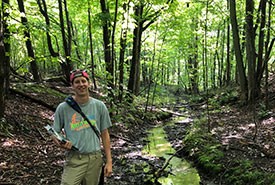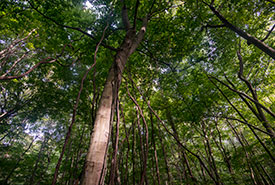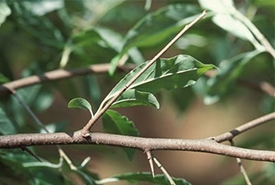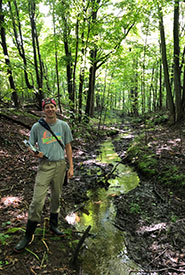Living out my passion for conservation

Brock Hussey (Photo by NCC)
I have always had a passion for nature, like many people in the conservation field. Growing up, I was always outside, surrounded by nature, observing the plants and animals around me. It wasn’t often you would find me without my eyes glued to a wildlife documentary, nose buried in a book about the species of North America or tugging at my grandfather’s sleeve, pestering him with my endless questions of “What bird is that?” or “What kind of tracks are those?” As I grew older, I accumulated a strong knowledge-base of species found near me and across the world. I quickly became the go-to person for my family and friends whenever there was a mystery creature to be identified.
I was always confident in what I knew, and having the ability to identify animals has certainly helped me in my career so far. Animals were always my strong suit. Plants, however, were not. When I started as a conservation technician at the Nature Conservancy of Canada (NCC) this past summer in Norfolk County, Ontario, I quickly realized how much more I had to learn. For the first time in my life, I wasn’t the go-to man for answers on what made up the environment we were in. At first it was overwhelming, but it quickly took me back in time; back to being a curious little boy eager to learn!
Related blog posts
Coming in on a short-term contract as a summer intern, I was thrown into the action within the first few days. I remember joining in on a hike on one of the restored fields NCC maintains and being amazed at how easily my co-workers and leaders could identify the plant species all around us. Much like when I was younger, I began asking, “What is this flower?” or “What kind of plant is that?” and, importantly, “How can you tell?” My companions were happy to teach me, and that was my introduction to a new skill set: plant species identification.

Forest canopy in Backus Woods, ON (Photo by Neil Ever Osborne)
Over the next few weeks, I slowly picked up some tricks to identify more plants with greater ease. However, nothing could have prepared me for the daunting task of monitoring over 100 permanent vegetation plots, which were established to help NCC determine how restored fields transition over time.
We had to go out into a restored field and find a two-by-two metre plot that had been in place for over 10 years. Every year, interns like me march out to find these plots and record every species of plant found within them. They also look at overall ground and canopy coverage. This is something that needs to be done efficiently and accurately. Being able to correctly identify which species are there is crucial in ensuring the data collected is useful. With the help of some very knowledgeable people, I quickly learned how to identify and properly record the species names into data sheets. This rigorous on-the-go training was an amazing opportunity to learn and possibly the best way for me to increase my familiarity with plants found in my local environment.

Autumn olive (Photo by James H. Miller)
Now that I knew the names of the plants found in the area that I was working in (the Southern Norfolk Sand Plain), I had a chance to expand my understanding further. One of the main responsibilities I was tasked with this summer was invasive species control. Once I got a grasp on which of the many species didn’t belong here in southern Ontario, I could be of much greater help in the recognition and removal of them. The more I learned, the more often I seemed to spot species such as autumn olive, multiflora rose, wild carrot and scots pine. I even began to notice invasive species along the roadside on my way to work, on walks with my family and in my own backyard. It was satisfying to know that every time I removed one of the invasive plants, I made room for native and potentially at-risk species in our natural areas. This sparked the fire that is my passion for conservation, and it has pushed me to learn more about how I can improve the natural world I live in.
Gaining the ability to identify native, invasive and at-risk species was the skill that improved the most for me this summer. Not only has it increased my confidence and experience within my future field of study, but it has also given me a massive boost in my overall ability, which will stick with me for the rest of my life.
I wish I had more time with NCC to continue my study, but I’m looking forward to continuing to learn more about these species and their impact on the environment. This experience has shown me how a relatively simple skill like plant identification can have a profound effect on conservation efforts.
The Conservation Internship Program is funded in part by the Government of Canada's Summer Work Experience program.


